Got tiny flying bugs buzzing around your fruit bowl or kitchen sink? You might be dealing with fruit flies! Don’t worry, these common household pests are more of a nuisance than a major problem, and fortunately, getting rid of fruit flies is quite easy and inexpensive. You likely have everything you need to create effective fruit fly traps right in your home.
We recently experienced a fruit fly issue in our kitchen – a rare occurrence for us after four years in this house. This gave me the perfect opportunity to put various fruit fly elimination methods to the test. I experimented with 7 different approaches, meticulously documenting the results (yes, there was even a spreadsheet involved!). Today, I’m sharing the best homemade fruit fly traps and step-by-step instructions on how to make them.
These DIY traps are simple to assemble using common household items and natural ingredients. They are incredibly DIY-friendly and completely chemical-free. If you prefer a humane approach, you can even release the trapped fruit flies outdoors instead of letting them perish. We’ll also cover essential tips for preventing fruit fly infestations in the first place.
Understanding Fruit Flies
Fruit flies are small, winged insects that are strongly attracted to ripe or fermenting fruits and vegetables, hence their name. They are also drawn to sugary substances and fermented drinks like beer, wine, and juice. You’ll often find them congregating around fruit bowls, garbage disposals, trash cans, and even kitchen drains. They are about the size of a grain of rice, resembling small, tan or brownish houseflies, often with distinctive red eyes. Fruit flies are most prevalent during summer and late fall when fruits are in season.
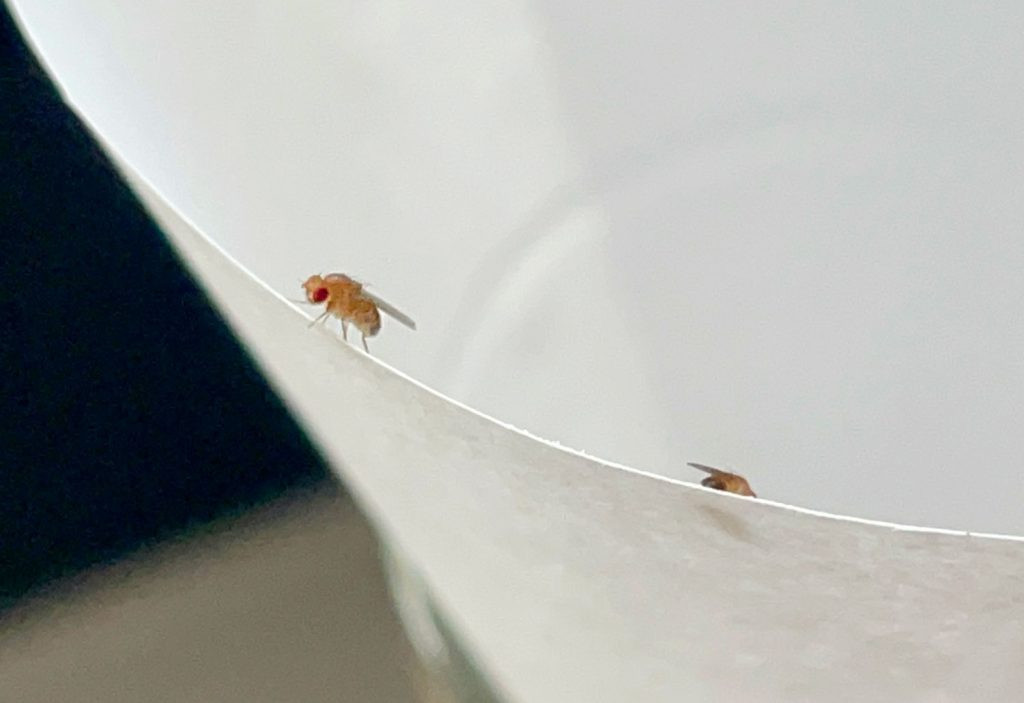 Close Up Of Fruit Fly On Paper Funnel
Close Up Of Fruit Fly On Paper Funnel
A fruit fly problem often begins when a few of these pests hitch a ride into your home on fruits or vegetables from the grocery store. However, female fruit flies are prolific breeders, capable of laying hundreds of eggs in their short lifespan, with eggs hatching in as little as 12 hours. They can reach adulthood in just a few days, meaning a small number of fruit flies can quickly multiply into a large infestation. This rapid reproduction cycle underscores the importance of addressing a fruit fly problem promptly.
Fruit Flies vs. Fungus Gnats vs. Drain Flies: Identification
Fruit flies are frequently confused with other small household insects, particularly fungus gnats and drain flies. While all are small flying pests, correctly identifying them is key to choosing the most effective elimination method. The easiest way to differentiate them is by observing their location and noticing which larger insect they most closely resemble:
- Fruit Flies: Look like small flies. Found near fruit bowls, garbage, or any decaying food sources.
- Drain Flies: Resemble small, fuzzy moths. Typically seen near sinks, drains, and damp areas.
- Fungus Gnats: Look like small mosquitos. Usually found near houseplants, as they breed in damp potting soil.
If you’re uncertain about which pest you’re dealing with, try one of the fruit fly traps described below. If it attracts the insects in your home, you’ve likely confirmed a fruit fly infestation!
4 Simple DIY Fruit Fly Trap Recipes
Getting rid of fruit flies doesn’t require complicated solutions or expensive products. All you need are a few common household items and a bit of patience. Each of these traps works on the same principle: attract the fruit flies into the trap and then prevent them from escaping. I tested these 4 DIY methods, and there was definitely a clear winner. Since each method utilizes items you probably already have at home, it’s worth trying more than one to see what works best for you. Think of it as a fun little science experiment in your kitchen! Here are the first 4 methods I experimented with:
- Funnel Trap
- Plastic Wrap Trap
- Dish Soap Trap
- Rotting Fruit Trap
I’ll provide detailed instructions for each method below, along with my findings on their effectiveness. Keep in mind that some traps work faster than others, and it may take several days to completely eliminate your fruit fly problem, regardless of the technique you choose.
#1: The Paper Funnel Fruit Fly Trap
This trap design lures fruit flies into a container through a small opening at the bottom of a paper funnel. The flies are attracted to the bait inside, but the funnel’s narrow opening makes it difficult for them to find their way back out.
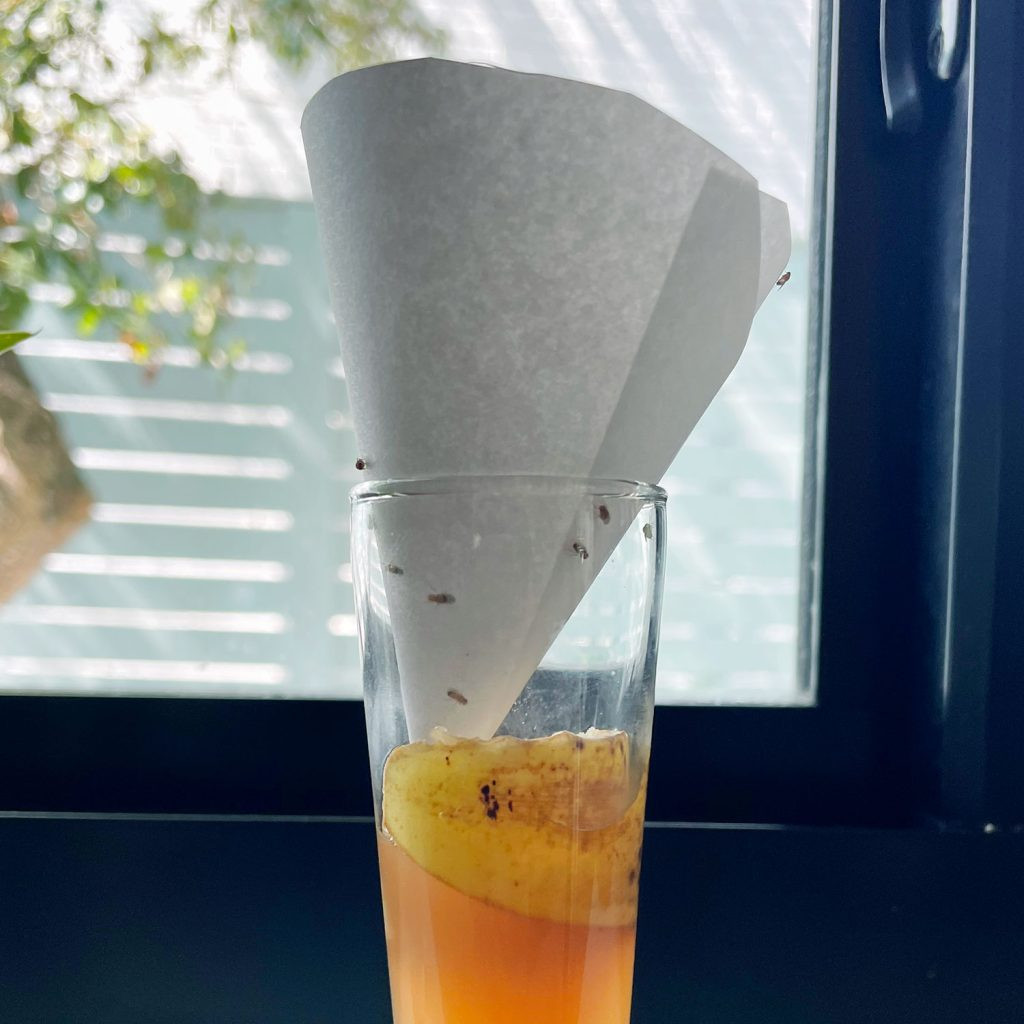 DIY Fruit Fly Trap With Paper Funnel
DIY Fruit Fly Trap With Paper Funnel
Supplies you’ll need:
- A small, clear jar, cup, or container, ideally with a narrow opening
- A piece of paper or cardstock
- Tape
- Scissors
- Apple cider vinegar (ACV)
Instructions:
- Choose your container: Select a small, clear container like a recycled food jar or a plastic bottle. For this method, a container with a smaller or narrower opening works best.
- Add apple cider vinegar: Pour a small amount of apple cider vinegar, old beer, or wine into the bottom of your container. The enticing scent will attract the fruit flies.
- Create the paper funnel: Shape a piece of paper or cardstock into a cone. The key is to create a very small opening at the pointed tip of the cone – about the size of a grain of rice. Secure the cone shape with tape. You can create the small opening either while forming the cone or by cutting the tip after taping.
- Position the funnel: Place the paper cone into the opening of your container, with the narrow tip pointing down into the jar. You might need to adjust the funnel shape so it sits securely on the container opening without touching the liquid bait. Ensure the funnel rests firmly against the edges of the opening to prevent flies from escaping through any gaps.
- Humane release (optional): To release the trapped fruit flies outdoors, carefully carry the entire trap outside, keeping the funnel in place (otherwise, the flies will escape before you get outside!). Then, remove the funnel and allow the fruit flies to fly away.
While you can use a store-bought funnel for this method, you may find that the opening at the bottom of many standard funnels is too large, allowing too many fruit flies to escape the trap.
#2: The Plastic Wrap Fruit Fly Trap
Similar to the funnel trap, this method uses the appealing scent of apple cider vinegar to attract fruit flies. They enter the trap through tiny holes poked in a plastic wrap cover, but then struggle to find their way back out.
Supplies you’ll need:
- A small, clear jar, cup, or container
- Rubber band
- Plastic wrap or a plastic bag
- Toothpick
- Apple cider vinegar (ACV)
The steps for making this plastic wrap trap are very similar to the funnel trap.
Instructions:
- Select your container: Choose a small, clear jar, cup, or any glass container. Almost any size will work, and it doesn’t need to be large. Using a clear container makes it easier to observe the trapped flies, but you can also use an old can or opaque container.
- Pour in apple cider vinegar: Pour apple cider vinegar into your chosen container. The vinegar’s aroma will attract the fruit flies. Old beer or wine also work well as alternatives, but avoid using regular white vinegar, as it’s not as attractive to fruit flies.
- Cover with plastic wrap: Stretch plastic wrap tightly over the opening of the container and secure it firmly with a rubber band. Saran wrap works perfectly, or you can cut a piece from a plastic bag.
- Poke small holes: Use a toothpick to carefully poke a few small holes in the plastic wrap cover. You don’t need many holes, but ensure they are large enough for a fruit fly to enter.
- Humane release (optional): To release the trapped flies outdoors, carefully take the trap outside without removing the plastic wrap (to prevent escapes). Once outside, remove the plastic wrap to let the fruit flies fly away.
Alternatively, you can adapt this method using a metal jar lid. Use a mason jar or an old food jar with a metal lid. Carefully use a hammer and nail to puncture a small hole in the metal lid instead of using plastic wrap.
#3: The Dish Soap Fruit Fly Trap
Unlike the previous two trap designs, this method doesn’t require a cover. Instead, it utilizes the properties of dish soap to trap the fruit flies. Important note: this method is not designed for humane release, as the soap will coat the flies.
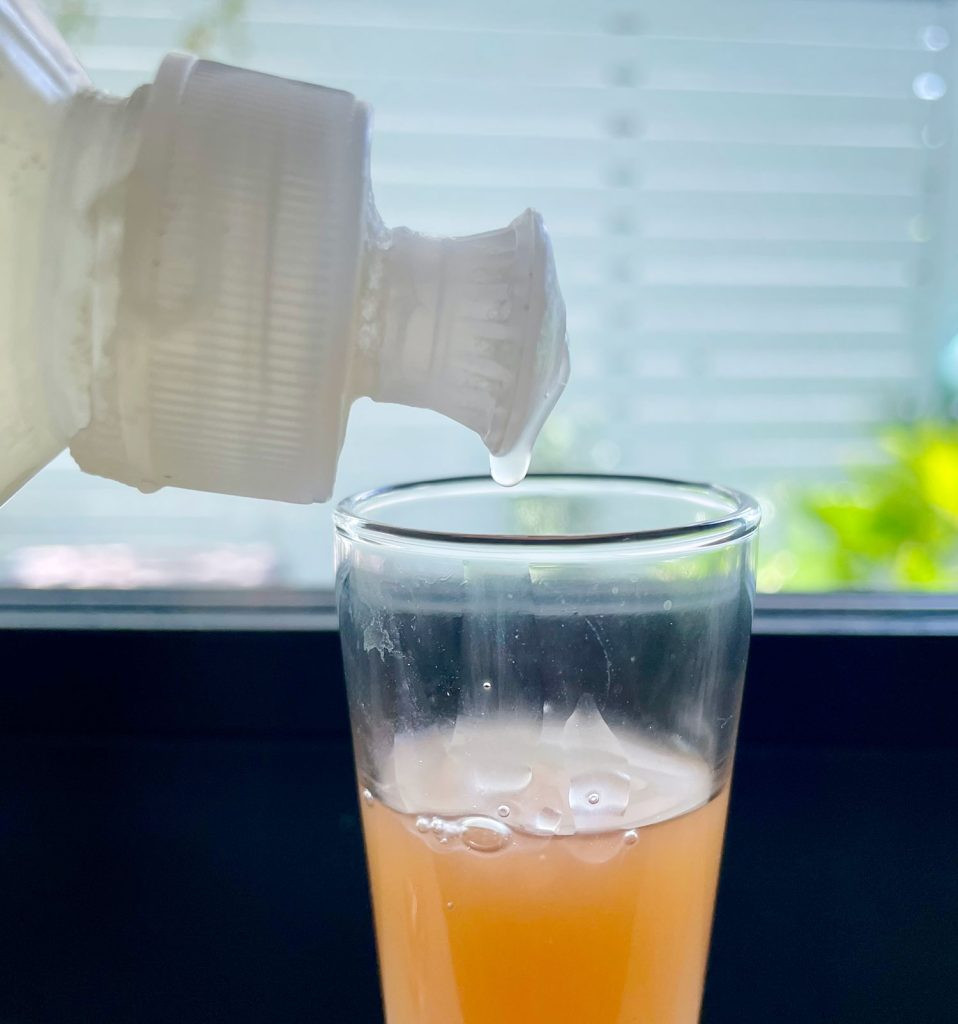 Dripping Dish Soap Into Apple Cider Vinegar For DIY Fruit Fly Trap
Dripping Dish Soap Into Apple Cider Vinegar For DIY Fruit Fly Trap
Supplies you’ll need:
- A small container, bowl, or dish
- Dish soap
- Apple cider vinegar (ACV)
This trap is incredibly simple to make:
- Pour apple cider vinegar: Similar to the other traps, pour a bit of apple cider vinegar into the bottom of a small container, bowl, or dish. The scent will attract the fruit flies.
- Add dish soap and mix: Add several drops of dish soap to the apple cider vinegar. Gently mix to create a soapy solution. The dish soap reduces the surface tension of the vinegar. Fruit flies will be attracted to the vinegar, land on the surface, and become trapped by the soapy solution, unable to fly away.
You can also enhance the plastic wrap or funnel traps by adding a few drops of dish soap to the apple cider vinegar before covering the top. This adds another way to trap the flies within your contraption.
#4: The Rotting Fruit Bait Trap
For this variation, instead of apple cider vinegar, we’ll use what fruit flies love most: actual fruit!
Supplies you’ll need:
- A small jar, cup, or container
- Plastic wrap or paper funnel, depending on your chosen trap mechanism (instructions #1 or #2)
- A small piece of ripe fruit, such as a banana peel or apple slice
To create a rotting fruit trap, simply replace the apple cider vinegar with a piece of banana peel, apple slice, peach, or other overripe fruit in either the Plastic Wrap Trap or the Funnel Trap setup described earlier. You can also combine a fruit scrap with apple cider vinegar to make the bait even more enticing. However, be prepared to replace the fruit scrap every day or two to prevent unpleasant odors in your kitchen as the fruit decomposes.
Finding the Best Fruit Fly Trap: Experiment Results
As shown in these photos, I tested 4 different DIY trap combinations to determine which performed best. The homemade traps I tested were:
- Plastic Wrap Trap with banana peel
- Funnel Trap with ACV + banana peel
- Plastic Wrap Trap with ACV + dish soap
- Dish Soap Trap with ACV
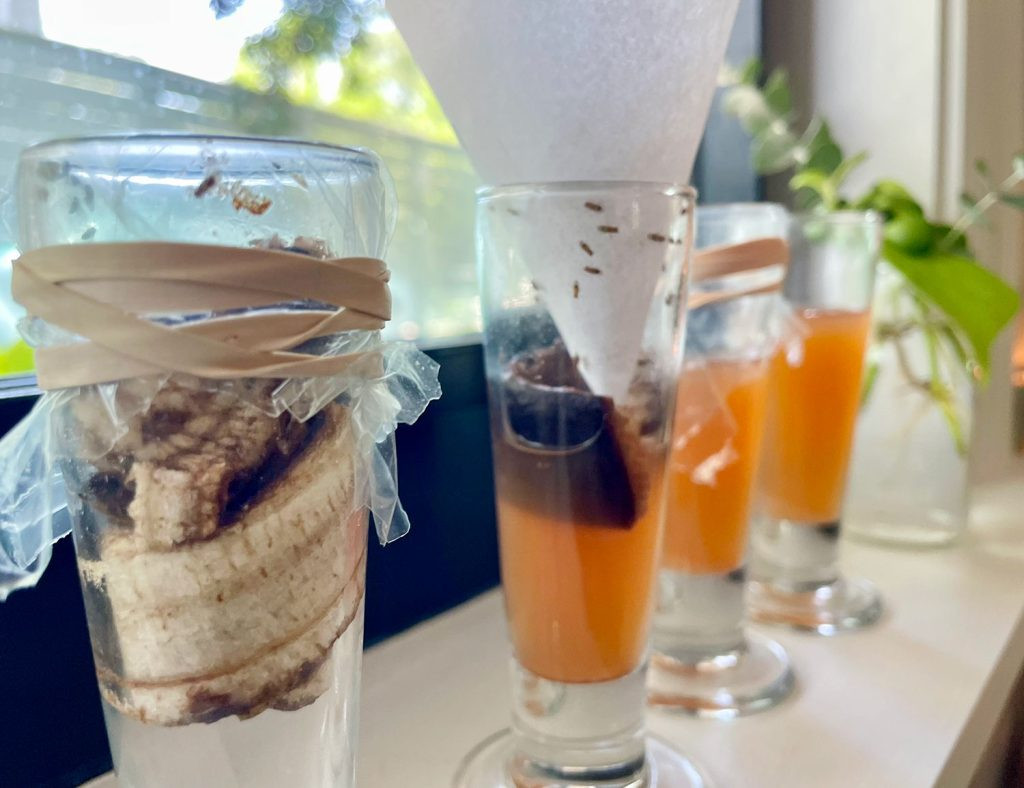 4 DIY Fruit Fly Traps Close Up
4 DIY Fruit Fly Traps Close Up
In my experiment, the type of trap container was less significant than the bait used. Traps using banana peel as bait performed significantly better than those using apple cider vinegar alone. The two plastic wrap traps were nearly identical in design, but the one baited with banana peel dramatically outperformed the one with apple cider vinegar and dish soap. Perhaps apple cider vinegar is less appealing when there’s real fruit nearby?
Based on these results, my recommendation is that no matter which trap style you choose, add a piece of fruit scrap to it! I slightly preferred the plastic wrap trap because it was simpler to assemble and less prone to accidental spills. I did knock over the funnel trap once, releasing some of the trapped flies back into the kitchen – oops!
What is the Most Effective Fruit Fly Attractant?
Driven by the success of fruit scraps, I decided to extend my experiment to determine which type of fruit is the most effective bait. I tested three readily available fruits: a banana peel, apple slices, and a strawberry. I placed each fruit in a separate Plastic Wrap Trap, side-by-side on the kitchen counter, for 24 hours.
While the banana peel initially seemed promising (it was the ripest at the start), the fruit flies ultimately showed the strongest attraction to the strawberry. The banana peel still caught a good number of flies, but the strawberry, as it became more fermented, attracted an increasing number of flies. Surprisingly, the apple slices didn’t catch a single fruit fly!
Store-Bought Fruit Fly Traps: A Convenient Alternative
If DIY traps aren’t working for you, or if you prefer a ready-made solution, there are several effective store-bought fruit fly traps available. These traps generally have excellent customer reviews and cost under $20. They might be a good option if you want a trap that also catches other types of small flying insects, or if you prefer a more discreet-looking trap compared to homemade versions.
 Collage of Storebought Fruit Fly Traps
Collage of Storebought Fruit Fly Traps
During my experiment, I purchased a pack of Terro Fruit Fly Traps to compare their performance to my DIY methods. I placed a Terro trap next to my banana and strawberry traps for 24 hours to see which of the three would catch the most flies.
Again, my homemade strawberry trap performed best, closely followed by the banana peel trap. The store-bought Terro trap caught only one fruit fly in the initial 24-hour period. HOWEVER…
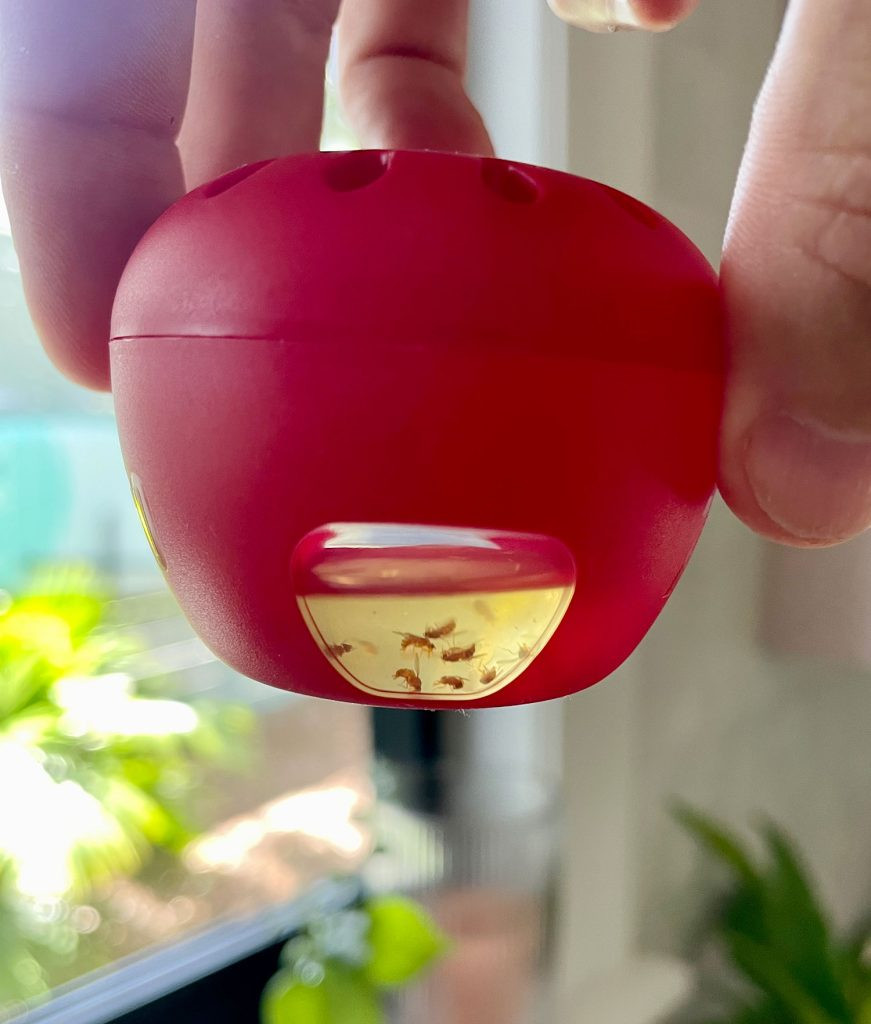 Terro Fruit Fly Trap With Dead Fruit Flies Visible
Terro Fruit Fly Trap With Dead Fruit Flies Visible
To get a clearer picture, I discarded my DIY traps and left the store-bought Terro trap out for another 24 hours. It was during this second day that the Terro trap caught the significant number of fruit flies you see in the photo above. So, the store-bought trap definitely works, but it wasn’t as quick or as effective as my homemade traps in the initial 24 hours. My conclusion? Store-bought traps are a good choice if you prefer a more discreet option, especially if you plan to leave a trap out long-term. However, homemade traps are often the quickest and most effective way to get rid of fruit flies immediately!
Preventing Fruit Flies: Simple Steps
While getting rid of fruit flies is relatively easy, preventing an infestation in the first place is always the best approach. Here are some simple preventative measures to keep fruit flies from becoming a problem in your home:
- Clean kitchen surfaces regularly: Wipe down kitchen countertops, stovetops, tables, and all surfaces that might collect food residue or spilled liquids. Fruit flies are especially attracted to fruit, sugary juices, and alcohol, so keep these areas clean!
- Take out the trash frequently: Food scraps left in your garbage can, especially overnight, can quickly turn your trash can into a breeding ground for fruit flies.
- Dispose of overripe fruit promptly: Regularly check your fruit bowl for overripe or rotting fruits like apples and bananas. Discard them before they become a fruit fly magnet.
- Wash fruits and vegetables immediately after bringing them home: Washing produce as soon as you get home from the store can help eliminate any fruit fly eggs or larvae that may be present (except for berries, which can spoil faster if washed before storing).
- Store produce in the refrigerator when possible: Fruit flies don’t thrive in cold temperatures. When in doubt, store fruits and vegetables in the refrigerator to deter them.
- Clean your sink drain regularly: Food particles and organic matter accumulating in your sink drain can also attract fruit flies. Run your garbage disposal regularly and flush the drain with hot water and a drain cleaner periodically to keep it clean.
Finally, remember not to panic if you spot fruit flies in your home. While it’s important to act quickly to prevent the problem from escalating, the solutions outlined in this article are simple, effective, and fast-acting. You might even find yourself enjoying a bit of “fruit fly science” in your own kitchen, just like I did!
*This post contains affiliate links, so we may earn a small commission when you make a purchase through links on our site at no additional cost to you.